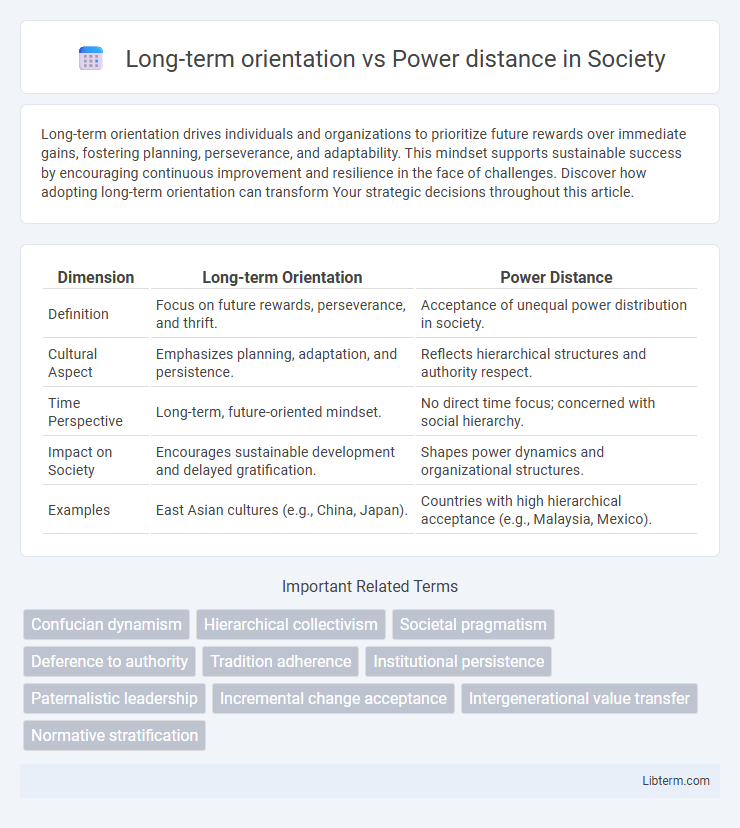Long-term orientation drives individuals and organizations to prioritize future rewards over immediate gains, fostering planning, perseverance, and adaptability. This mindset supports sustainable success by encouraging continuous improvement and resilience in the face of challenges. Discover how adopting long-term orientation can transform Your strategic decisions throughout this article.
Table of Comparison
| Dimension | Long-term Orientation | Power Distance |
|---|---|---|
| Definition | Focus on future rewards, perseverance, and thrift. | Acceptance of unequal power distribution in society. |
| Cultural Aspect | Emphasizes planning, adaptation, and persistence. | Reflects hierarchical structures and authority respect. |
| Time Perspective | Long-term, future-oriented mindset. | No direct time focus; concerned with social hierarchy. |
| Impact on Society | Encourages sustainable development and delayed gratification. | Shapes power dynamics and organizational structures. |
| Examples | East Asian cultures (e.g., China, Japan). | Countries with high hierarchical acceptance (e.g., Malaysia, Mexico). |
Understanding Long-term Orientation in Cultural Contexts
Long-term orientation reflects a culture's emphasis on future rewards, perseverance, and thrift, contrasting with power distance, which measures acceptance of hierarchical inequality and authority distribution. Understanding long-term orientation requires analyzing how societies prioritize sustained growth, adaptability, and long-range planning over immediate results. Cultures with high long-term orientation often exhibit strong respect for tradition and strategic innovation, influencing business practices and interpersonal relationships significantly.
Defining Power Distance: Key Concepts and Implications
Power distance refers to the extent to which less powerful members of a society accept and expect power to be distributed unequally, influencing organizational hierarchies and social dynamics. High power distance cultures emphasize centralized authority and clear status differences, which can impact communication and decision-making processes. Understanding power distance is crucial for designing effective leadership strategies and fostering cross-cultural collaboration in diverse environments.
Historical Roots of Long-term Orientation
Long-term orientation stems from Confucian values emphasizing perseverance, thrift, and adapting traditions to modern contexts, shaping cultures that prioritize future rewards over immediate gains. In contrast, power distance reflects established hierarchical structures rooted in historical governance and social stratification, influencing acceptance of unequal power distribution within societies. Understanding these historical roots highlights how Confucian philosophy drives long-term orientation while entrenched political institutions reinforce power distance dynamics.
Origins and Influences of Power Distance
Power distance originates from historical social hierarchies and cultural norms that shape attitudes toward authority and inequality within societies. It is influenced by political systems, economic development, and education levels, which determine acceptance of unequal power distribution. Long-term orientation interacts with power distance by emphasizing perseverance and adaptation to social roles over generations in high power distance cultures.
Long-term Orientation vs Power Distance: A Comparative Overview
Long-term orientation emphasizes future rewards, perseverance, and thrift, encouraging societies to adapt and plan for the distant future, while power distance reflects acceptance of unequal power distribution and hierarchical order within a society. Cultures with high long-term orientation tend to prioritize sustained growth and innovation over immediate gains, contrasting with high power distance cultures where authority and status are strongly respected and rarely challenged. Understanding the interplay between these dimensions reveals how societies balance respect for hierarchy with a focus on enduring success and adaptability.
Impact on Organizational Structure and Leadership Styles
Long-term orientation fosters organizational structures that emphasize adaptability, employee development, and sustained growth, promoting participative leadership styles that encourage innovation and future planning. In contrast, high power distance creates hierarchical organizational structures marked by centralized decision-making and authoritative leadership, reinforcing clear status distinctions and top-down communication. The interplay between these cultural dimensions shapes leadership effectiveness, determining whether organizations prioritize flexibility and long-term goals or rigid authority and immediate control.
Decision-Making Processes in Different Cultural Dimensions
Long-term orientation emphasizes future rewards and persistence in decision-making, encouraging strategic planning and adaptability over immediate results. In contrast, high power distance cultures centralize decision-making authority, where hierarchical structures limit employee participation and prioritize top-down directives. Understanding these dimensions aids multinational organizations in tailoring decision-making processes to balance sustained growth with respect for cultural authority expectations.
Influence on Social Relationships and Communication Patterns
Long-term orientation encourages stable, enduring relationships and promotes indirect, context-sensitive communication to preserve harmony and achieve future goals. In contrast, high power distance enforces hierarchical social structures, resulting in formal communication patterns where subordinates defer to authority and avoid open disagreement. These cultural dimensions shape social interactions by balancing respect for tradition and authority with the emphasis on relational continuity over time.
Case Studies: Countries Exemplifying Each Dimension
China exemplifies long-term orientation through its emphasis on perseverance, thrift, and adapting traditions to modern contexts, as seen in business strategies fostering sustained growth. In contrast, Malaysia demonstrates high power distance, where hierarchical structures in organizations and societal respect for authority are deeply ingrained, influencing decision-making processes and communication patterns. Comparative studies reveal that these dimensions impact workplace dynamics, with long-term orientation promoting strategic planning, while high power distance emphasizes centralized authority and formal roles.
Navigating Cross-Cultural Interactions: Strategies and Best Practices
Navigating cross-cultural interactions requires understanding the contrast between long-term orientation and power distance to tailor communication and decision-making strategies effectively. Cultures with high long-term orientation prioritize perseverance and future rewards, demanding patience and strategic planning, while those with high power distance emphasize hierarchical structures, requiring respectful acknowledgment of authority and clear role definitions. Adopting flexible leadership approaches and fostering open dialogue facilitate collaboration across these differing cultural dimensions, enhancing mutual respect and productive outcomes.
Long-term orientation Infographic

 libterm.com
libterm.com